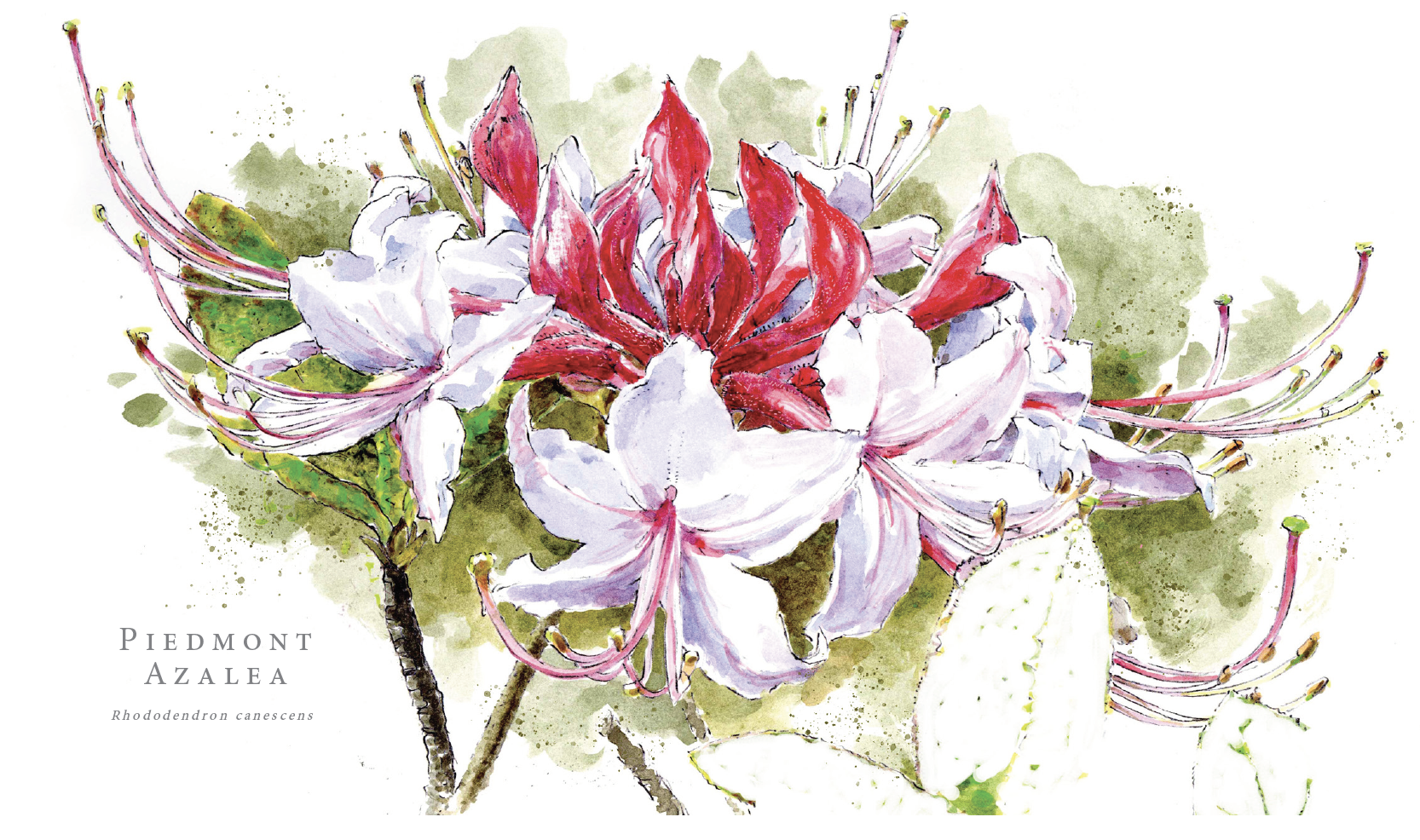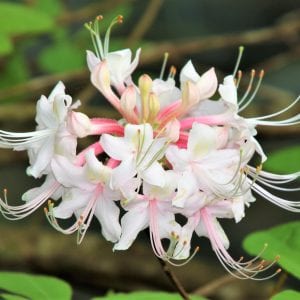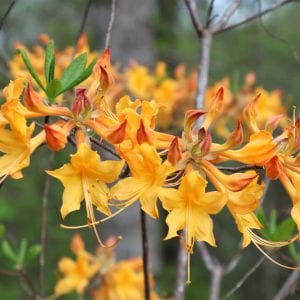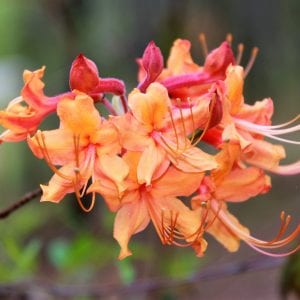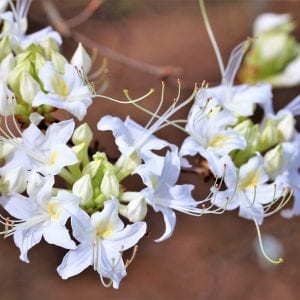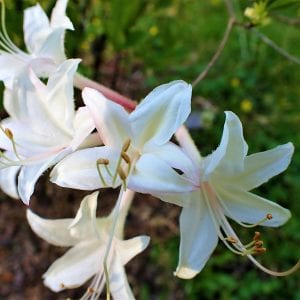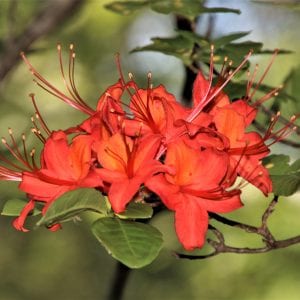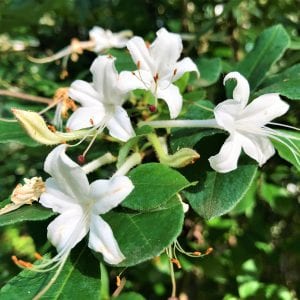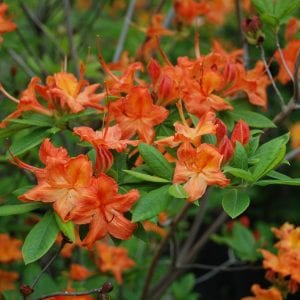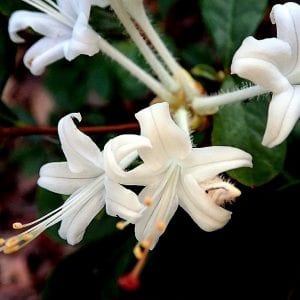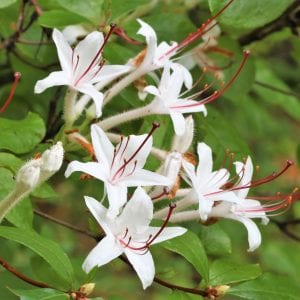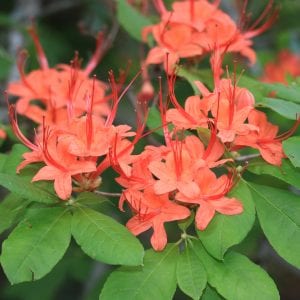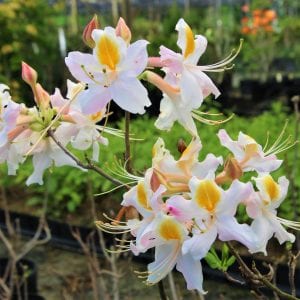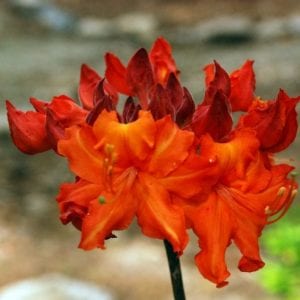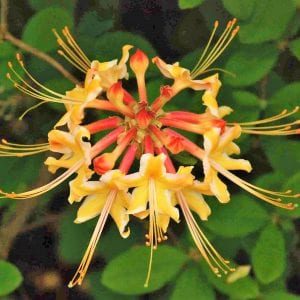Landscaping

Native azaleas bloom throughout the spring and into the summer presenting a spectacular flower show like none other. Learn about landscaping with azaleas and the many varieties.
Gardeners and plant enthusiasts anxiously await the spring display of flowering cherries, evergreen azaleas, and dogwoods as well as an array of colorful bedding plants. But unless you get off the beaten path, you may not notice the monarch of all native plants, the native azalea, which is one of the most prized of all flowering trees or shrubs. Native azaleas bloom throughout the spring and into the summer and present a spectacular flower show like none other. Once you experience them, you will fall in love with these wonderful and enchanting native plants.
Unlike the typically planted evergreen azaleas and common plants blooming in yards and landscapes, native azaleas are harder to find but certainly have qualities worth the search. Most species are fragrant, and some fantastically so. They are typically found growing in undisturbed natural areas in forests and along creeks from Texas up to Maine. In Alabama, they are often found along hillsides and steep terrain as well as along streams, but occasionally where you least expect them. Native azaleas go nearly unnoticed year- round and blend in with their natural surroundings until they bloom. It is then that their beauty is discovered and they become a spectacular spring-to-summer highlight.
Native azaleas are often referred to as deciduous azaleas or American azaleas and mistakenly called “wild honeysuckle.” Native azaleas are deciduous, which means they lose their leaves in winter, and they are also indigenous to America. In contrast, the popular landscape azaleas are evergreen and originate in Asia. In the southeastern United States, we have at least 17 species, making us the undisputed world capital of deciduous azaleas. Physically, most native azaleas have the form of a small upright tree rather than the round mounding shrub form of evergreen azaleas.
The honeysuckle-like flowers of native azaleas grab attention and make them unique. The funnel-shaped flowers range in colors and shades of pink, white, yellow, orange, and red, depending on the species and breeding. Some even have flowers with a delightful fragrance. The individual florets are trumpet-shaped and borne in large terminal clusters. Identification of native azaleas can sometimes be difficult because of the similarities among species. Natural hybridization produces intermediate forms with atypical flower colors. Hybrid azalea breeders make crosses to have larger trusses and a wider array of color shades and combinations.
Landscaping with Native Azaleas
The true beauty of native azaleas is seen when you find them growing in the wild. Thanks to modern horticulture techniques and plant availability, however, you don’t have to walk deep into the forest or along a steep hill to enjoy their beauty. Many species, selections, and cultivars are available for purchase to be incorporated into the home landscape for personal enjoyment. Their popularity fits the growing trend and interest in incorporating native plants and natural areas into the residential landscape. Many homeowners prefer a natural woodland landscape over formal gardens and manicured lawns, thus presenting many opportunities to add beloved native azaleas to residential gardens.
When planting native azaleas, place them away from houses and in natural areas where they physically look like they belong. Planting location and species selection are important for long-term success. Most native azaleas prefer cool, partially shaded sites with rich, moist woodland soil. A filtered shade location, such as under pine trees or in openings among hardwoods, is recommended. A general rule is to choose a site with morning sun and afternoon shade.
In heavy shade, most azaleas grow slowly and produce fewer blooms. The early blooming ones tend to do better in more sun. Some species can tolerate full sun to part shade better when water is available. If late-blooming species are planted in full sun, the blooms will not be showy for long unless regularly watered. Most species will die, however, if left in soggy conditions for an extended time.
Azaleas require an acidic soil pH to grow properly. Check the soil pH of your site before you buy and plant azaleas. Amend the soil to achieve a pH range of 5.0 to 6.0.
For additional information on planting azaleas, refer to Extension publication ANR-0200, “Evergreen Azaleas for Alabama.”
Variety Selection
Seventeen species of native azaleas can be found growing wild all across the Southeast, ten of which have been recorded in Alabama. One reason native azaleas are so popular is the many different kinds to choose from. With some perseverance, one can find or have a type of native azalea blooming from early spring to fall. Early blooming native azaleas are extremely showy early in the spring before the plants leaf out completely; however, later- blooming native azaleas offer flowers as well as a nectar source for bees and butterflies throughout the summer.
The following are species of native azaleas recommended for residential landscapes. They are either native to Alabama or will grow well in most areas of the state. This list is arranged in order of bloom time for central Alabama.
* Non-Native to Alabama
Piedmont Azalea
(Rhododendron canescens) is common in Alabama and is the first to bloom in the spring from late March to early April. It has fragrant white to pink flowers and grows up to 15 feet tall. It is one of the widely distributed species found growing wild in the southeastern states often along creeks and power line cuts.
Florida Azalea
(Rhododendron austrinum) produces fragrant yellow to pale orange flowers in late March to early April. It is native to northwest Florida, southwest Georgia, south Alabama, and southeast Mississippi. It can grow to about 15 feet tall. Recently, other natural color variations have been documented.
Oconee Azalea*
(Rhododendron flammeum) is native to western central Georgia to South Carolina. It blooms in late March through April as the new leaves emerge. It is nonfragrant with highly variable shades of yellow, orange, and red-orange flowers. Specimens range from 6 to 8 feet tall.
- Piedmont Azalea
- Florida Azalea
- Oconee Azalea
Alabama Azalea
(Rhododendron alabamense) has snow-white flowers, typically with yellow blotch, and a lemon fragrance. Some are low shrubs while others grow to 4 to 12 feet tall. It blooms in April and may be found growing wild in much of Alabama and adjacent states. It is now uncommon even in Alabama because of modern forestry practices and developments.
Coastal Azalea*
(Rhododendron atlanticum) is native to the East Coast from Delaware to Georgia. It is useful in the landscape because of its short height, spreading colonial habit, and better-than-average drought hardiness. Its white flowers flushed with red are extremely fragrant and appear in April and May.
Red Hills Azalea
(Rhododendron colemanii) is a newly discovered large species that can grow to 20 feet tall. It sports a variety of flower colors including white, pink, salmon, light orange, and all shades between, both with and without a blotch. The flowers bloom in May and are very fragrant.
- Alabama Azalea
- Coastal Azalea
- Red Hills Azalea
Cumberland Azalea
(Rhododendron cumberlandense) has nonfragrant orange to red flowers that open in May to early June. It is native
to high elevation ranges of Kentucky, Tennessee, north Georgia, and north Alabama. Size can vary from 2 to 5 feet tall with the potential of growing to 10 feet tall.
Swamp Azalea
(Rhododendron viscosum) blooms from mid-May to early June. Its slender tubular flowers are white (rarely pink) and fragrant. It is native to Alabama and can be found in Mississippi, Florida, and areas up the East Coast as far as Maine. Most plants are usually low-growing under 8 feet.
Flame Azalea*
(Rhododendron calendulaceum) is native to the Appalachian Mountains region and is found in the wild in north Georgia and areas northward. It is a large plant that can grow to 15 feet tall. Its large flowers can vary greatly from orange to yellow to red. It blooms around late May to early June.
- Cumberland Azalea
- Swamp Azalea
- Flame Azalea
Hammocksweet Azalea
(Rhododendron serrulatum) has fragrant white flowers, grows 10 to 15 feet tall, and blooms from June to September. It is the southernmost native azalea, with a range extending along the Gulf Coast. It has the most vertical growth habit, typically three times taller than wide.
Sweet Azalea
(Rhododendron arborescens) is native to the Appalachian Mountains and foothills and has very fragrant white flowers. Common near streams, it can grow to more than 10 feet tall. Bloom time is from May to August. One form common in central Alabama flowers in July, August, and sometimes later.
Plumleaf Azalea
(Rhododendron prunifolium) is native to only a small area in southwestern Georgia and southeastern Alabama. It has nonfragrant orange-red to deep-red flowers and grows up to 20 feet tall. This azalea is a special summer feature that blooms from July to September.
- Hammocksweet Azalea
- Sweet Azalea
- Plumleaf Azalea
In addition to the native species, many selections and hybrids of native deciduous azaleas have been developed by plant breeders for home landscapes. Much of the deciduous azalea breeding has been done in the cooler climates of northwestern Europe. This was the result of the popularity of horticultural hobbies and hybridization in the late nineteenth and early twentieth centuries. Unfortunately, many of these beautiful hybrids cannot endure the heat of the southeastern United States.
Hybrid groups with poor heat tolerance:
- Belgium hybrids combined the single deciduous species from Europe, R. luteum, with several of the North American deciduous azalea species.
- Mollis hybrids include Asian deciduous azaleas in the breeding program.
- Knap Hill hybrids were bred in England by Anthony Waterer using Belgium and Mollis hybrids as well as more plants from North America.
- Exbury hybrids were bred at the estate of Lionel De Rothschild using Knap Hill hybrids and more plants from North America.
- Northern Lights hybrids were bred for Minnesota winters using Mollis hybrids and R. prinophyllum
- ‘Touch of Pink’
- ‘Aubie’ x ‘War Eagle’
- ‘Millie Mac’
Hybrid groups with better heat tolerance:
- Aromi hybrids:‘ClearCreek’,‘Tallulah Sunrise’, ‘Radiant Red’, ‘Touch of Pink’, ‘Four Kings’
- Auburn series: ‘Aubie’,‘Tiger’,‘WarEagle’, ‘Plainsman’, ‘Patsy’s Pink’, ‘Samford Sorbet’
- Confederate series: ‘AdmiralSemmes‘, ‘Robert E. Lee’, ‘Frederick O’ Douglas’, ‘Stonewall Jackson’
- Sommerville series: ‘JackMelton’,‘Magenta Rose’, ‘Orange Carpet’, ‘Razzbury’
- Strickland azaleas: ‘Kelly’sRed’,‘Pierce Whiddon’
- Clarence Towe’s selections: ‘Gamecock’, ‘Keowee Sunset’, ‘Magic Pink’
Native species selections with good heat tolerance:
- Lazy K Azaleas: R. alabamense ‘Nancy Callaway’, R. canescens ‘Chocolate Drop’, and R. flammeum ‘Red Inferno’
 Shane Harris, County Extension Coordinator, Home Grounds, Gardens, and Home Pests; Chip East, Regional Extension Agent, Commercial Horticulture; and Patrick Thompson, Curator, Davis Arboretum, all with Auburn University
Shane Harris, County Extension Coordinator, Home Grounds, Gardens, and Home Pests; Chip East, Regional Extension Agent, Commercial Horticulture; and Patrick Thompson, Curator, Davis Arboretum, all with Auburn University
New March 2021, Native Azaleas for Alabama, ANR-2747

